There is an unbelievable number of waterfalls in Iceland. As many as 10,000 waterfalls grace the tiny island. It seems like around every bend is a waterfall more beautiful than the last, and each in their own unique way. What makes Seljalandsfoss waterfall so special is that you can walk behind it! Let’s learn more about this stunning waterfall as we help you plan a perfect visit.
In This Guide
Here’s what we’re covering in this guide. We invite you to read the full post or jump ahead to the section you’re most interested in.
- What is Seljalandsfoss waterfall?
- What it’s like to walk behind Seljalandsfoss waterfall
- Discover Gljufrabui – The hidden waterfall just steps from Seljalandsfoss
- Plan your visit to Seljalandsfoss
- Tips for visiting Seljalandsfoss
- Where to stay near Seljalandsfoss
- How to fit Seljalandsfoss waterfall into your Iceland Itinerary
What is Seljalandsfoss waterfall?
Seljalandsfoss waterfall is one of Iceland’s most famous waterfalls, largely due to the fact that you can walk behind it. Photos from the cavern behind Seljalandsfoss (shot by photographers far more skilled than either of us) are some of the most iconic images of Iceland.
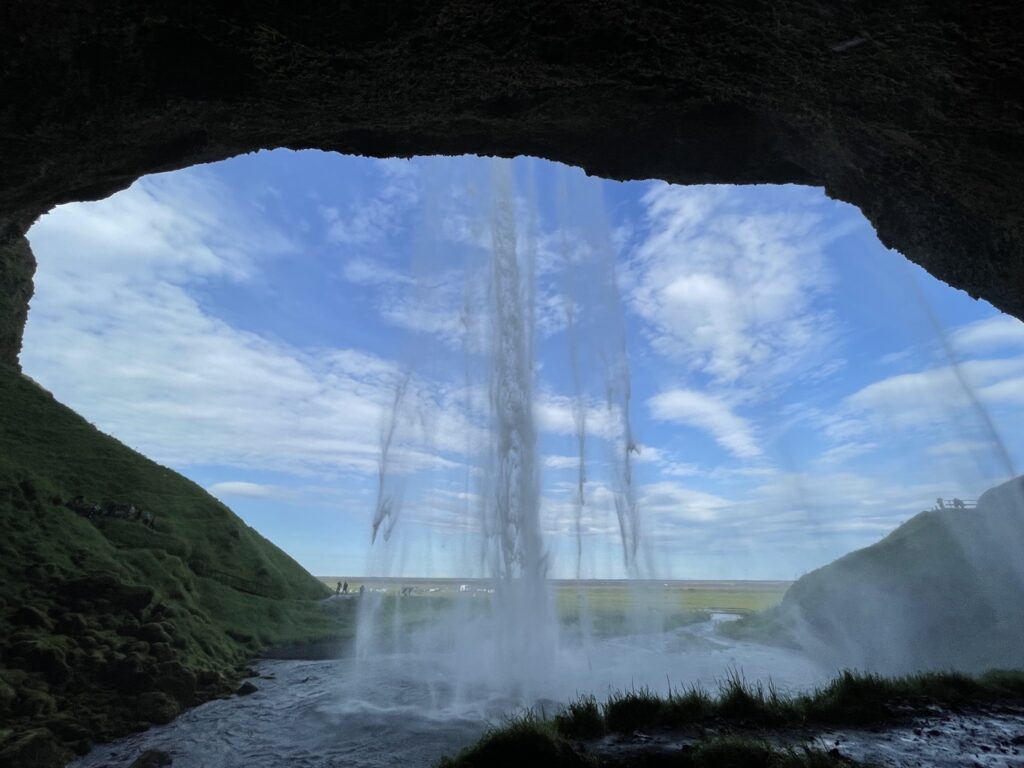
The waterfall is single-tiered and falls about 200 feet down from the edge of the cliff to the meadow below. The water forms a small and relatively still pool, which continues to flow in a smaller stream that meanders through the meadow.
The waterfall is nowhere near the tallest waterfall in Iceland (200 ft compared to the tallest which tower over 700 ft), nor is it the largest in volume (35 cubic feet per second compared to some or the largest which reach over 9,000 cfs). Its claim to fame comes primarily for its unique positioning over a cavern, which allows visitors to walk behind it.

Seljalandsfoss is far from a hidden gem. It’s a very popular stop for travelers on Iceland’s Ring Road or anyone visiting the southern region. It’s also a short distance from Reykjavik, making it a popular day trip and tour group destination. Seljalandsfoss saw over 900,000 visitors in 2018 (the most recent numbers I could track down).
What it’s like to walk behind Seljalandsfoss waterfall
The journey begins on a paved sidewalk from the parking lot leading to the waterfall. The path soon splits; stay right and follow the path counter-clockwise behind the falls.
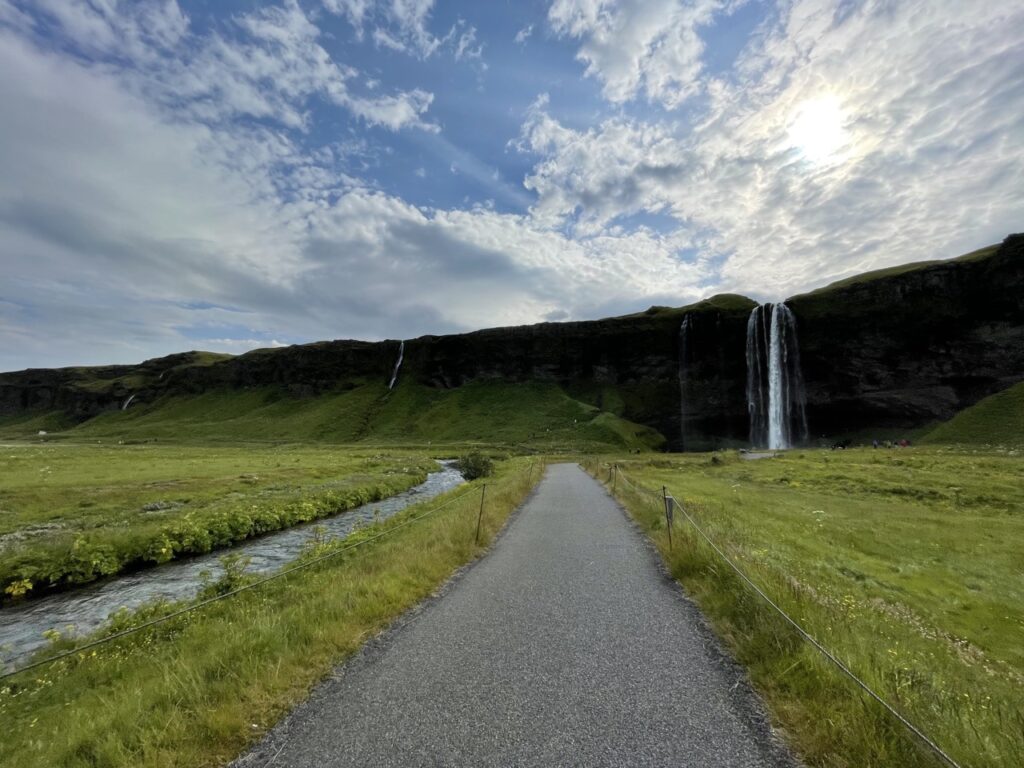
As you approach the base of the falls, you’ll hit stairs which scale the steepest portion of the path. The stairs are wet, but have decent traction and handrails. This portion is the most difficult in terms of elevation, but also has the most stable footing.
At the top of the stairs, you’ll arrive at the cavern behind the falls. This area is relatively wide and flat. This is where can enjoy the view and take a break.
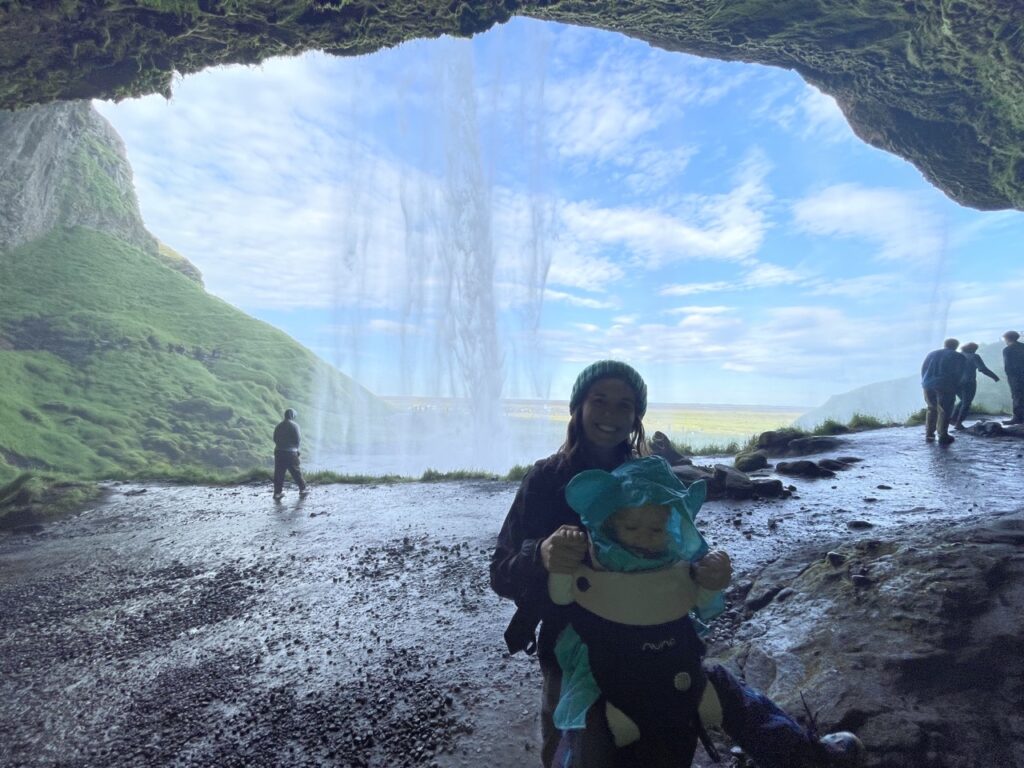
If you continue counter-clockwise after the falls, you’ll reach a second incline. Instead of stairs, this section begins as a rocky pathway and stone steps. It’s not super steep, but the rocks are wet and there are no handrails. The rocks eventually give way to stairs which lead down to the paved flat path.
I found this last section to be the hardest part of the walk, though I was doing it with a child strapped to the front of me.

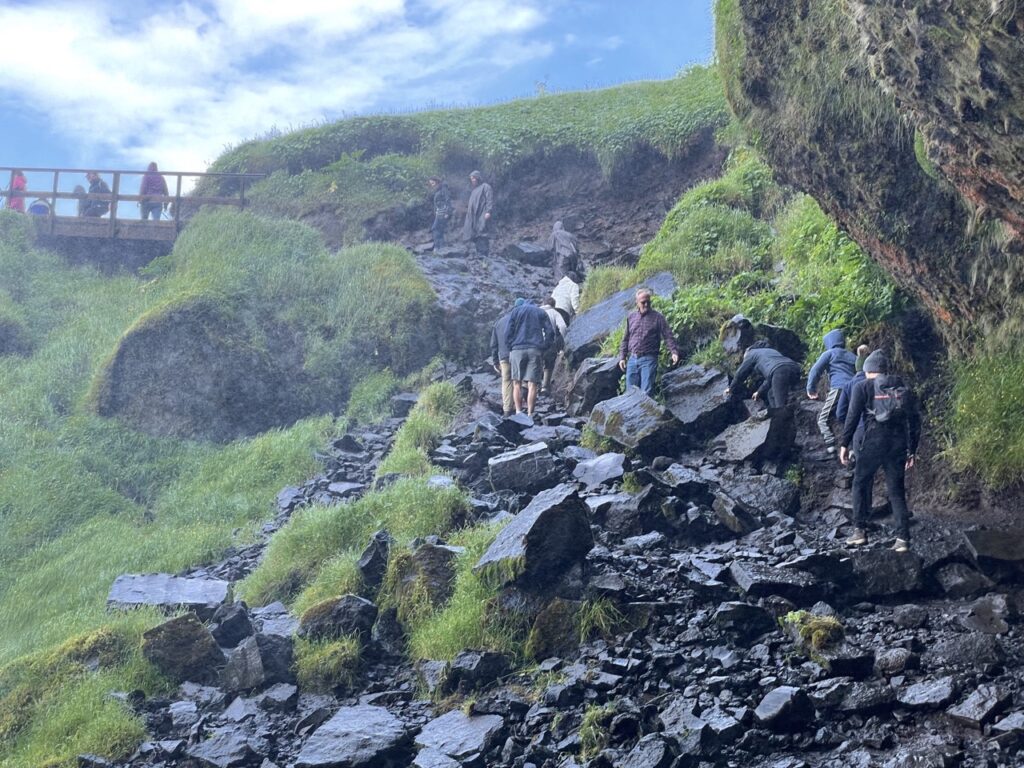
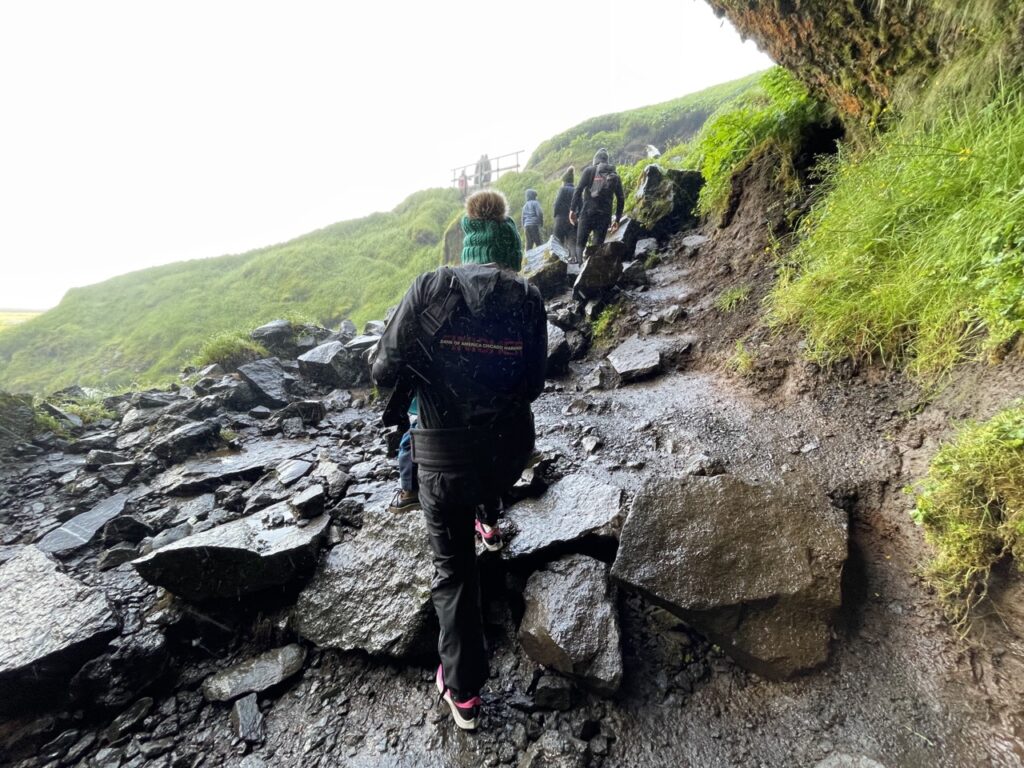
If you can’t complete this rocky portion, you may want to backtrack and return going down the same steps you walked up. You’ll be going against the crowd so it may take longer, but don’t feel bad if that’s the safest option for you.
I would describe the hike behind Seljalandsfoss as moderately difficult. The walk is short in distance — less than 0.5 mile — but with an elevation gain of about 200 feet. There are stairs and handrails in some areas, but others are rocky. The entire journey can be wet and slippery.
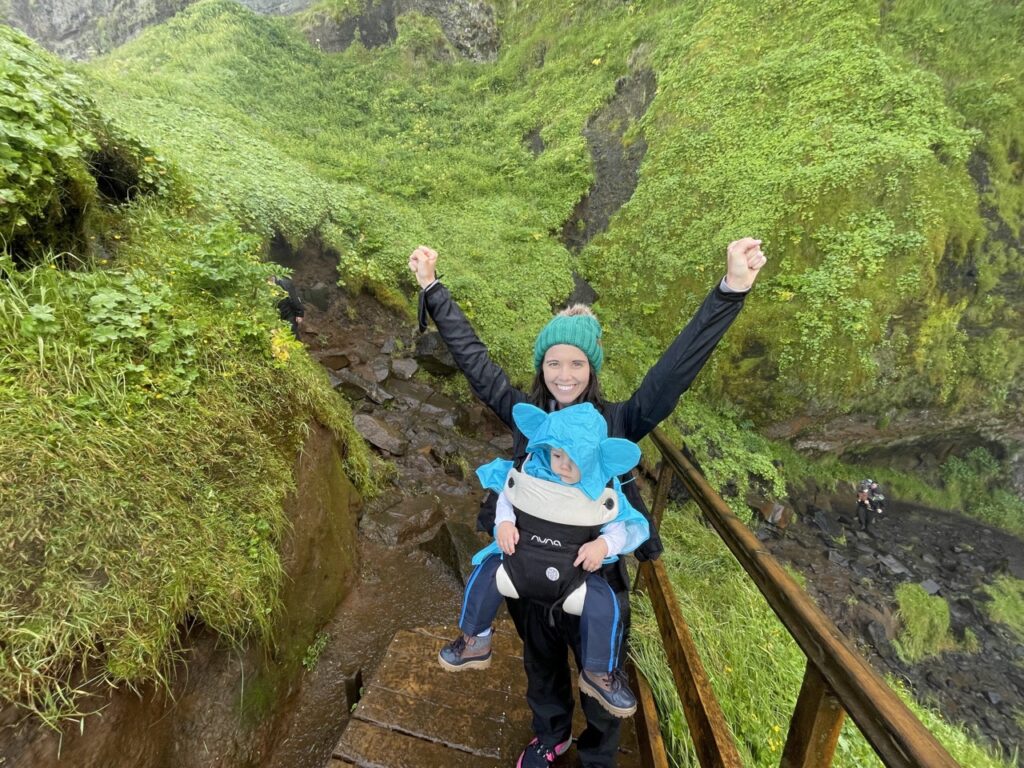
The path behind Seljalandsfoss is closed during the winter months when the path becomes impassable and dangerous.
Discover Gljufrabui – The hidden waterfall just steps from Seljalandsfoss
As soon as you arrive at the parking lot, you’ll immediately see that Seljalandsfoss isn’t the only waterfall nearby. There are a couple other falls that cascade down the nearby cliffs, including one that seems to disappear behind some large rocks.
This waterfall is called Gljufrabui, and with a little work and good weather, you can actually see it up close.
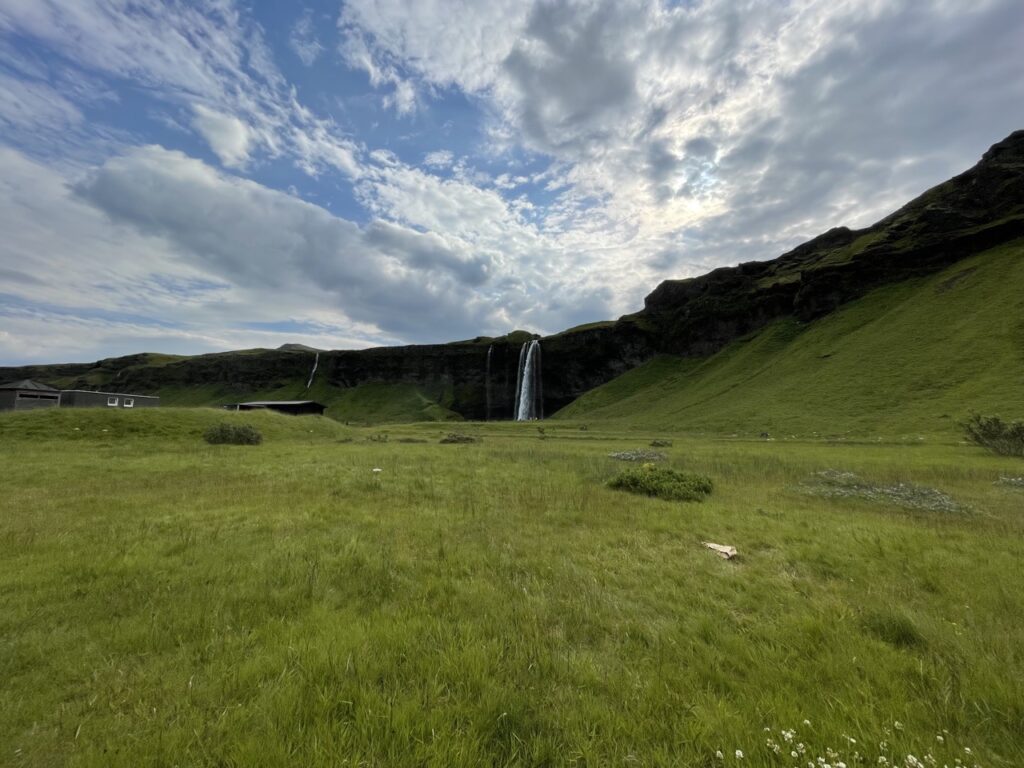
Fun fact: the name Gljufrabui translates to ‘one who lives in a canyon.’
How to find the hidden waterfall by Seljalandsfoss
The base of Gljufrabui might be hidden, but the falls themselves are no secret. At the bottom of the stairs at the end of the path from Seljalandsfoss, there’s a sign pointing toward the hidden falls of Gljufrabui.

The footpath between the two falls is just under half a mile. When you arrive at Gljufrabui, you’ll see a small sign, the very top of the waterfall, and a glimpse of the complete falls inside the cavern.
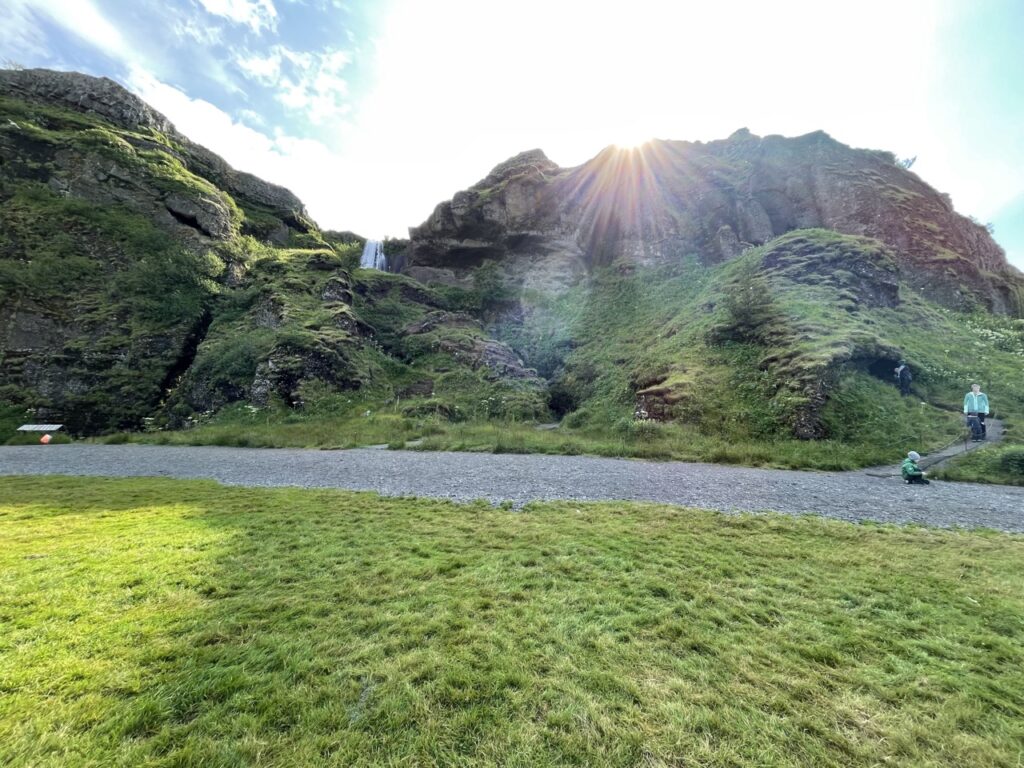
The only way to enter the cavern that hides the waterfall is to walk through the stream which runs through the narrow opening between the rocks. The time of year you visit and recent rainfall will determine how deep that stream is and whether you can safely reach the cavern to see the waterfall up close.
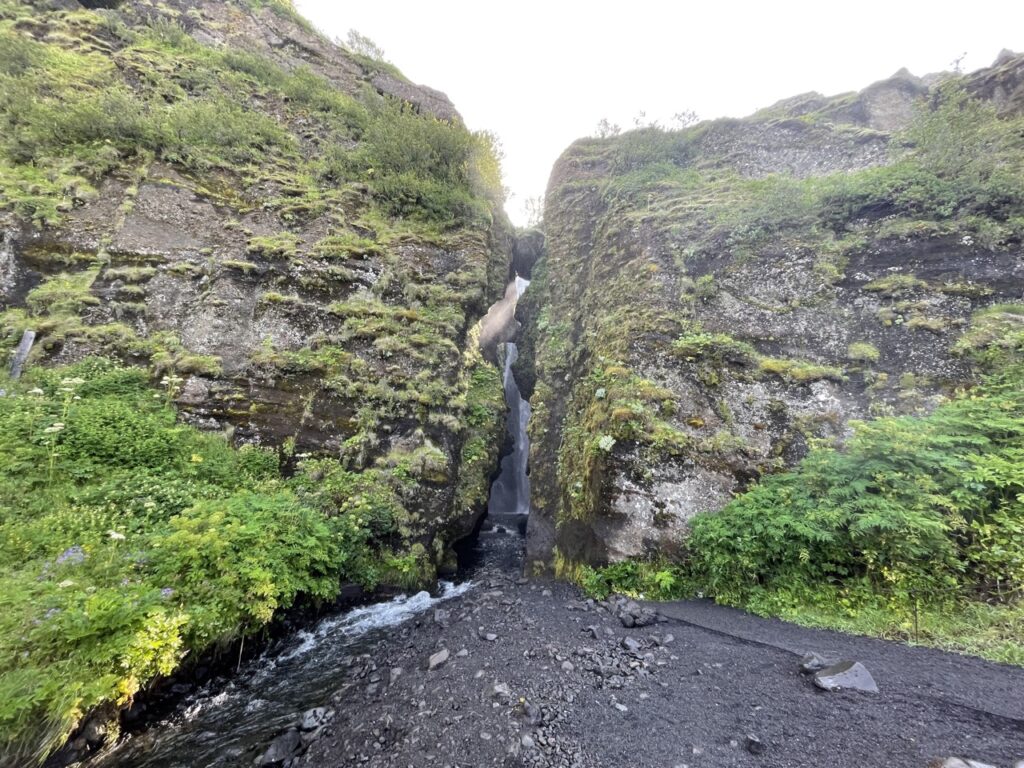
We visited in July and the stream was quite shallow — a few inches to a foot. The rocks on the side of the stream were largely above water. We were able to mostly walk on those rocks, taking a few steps into the stream for balance.
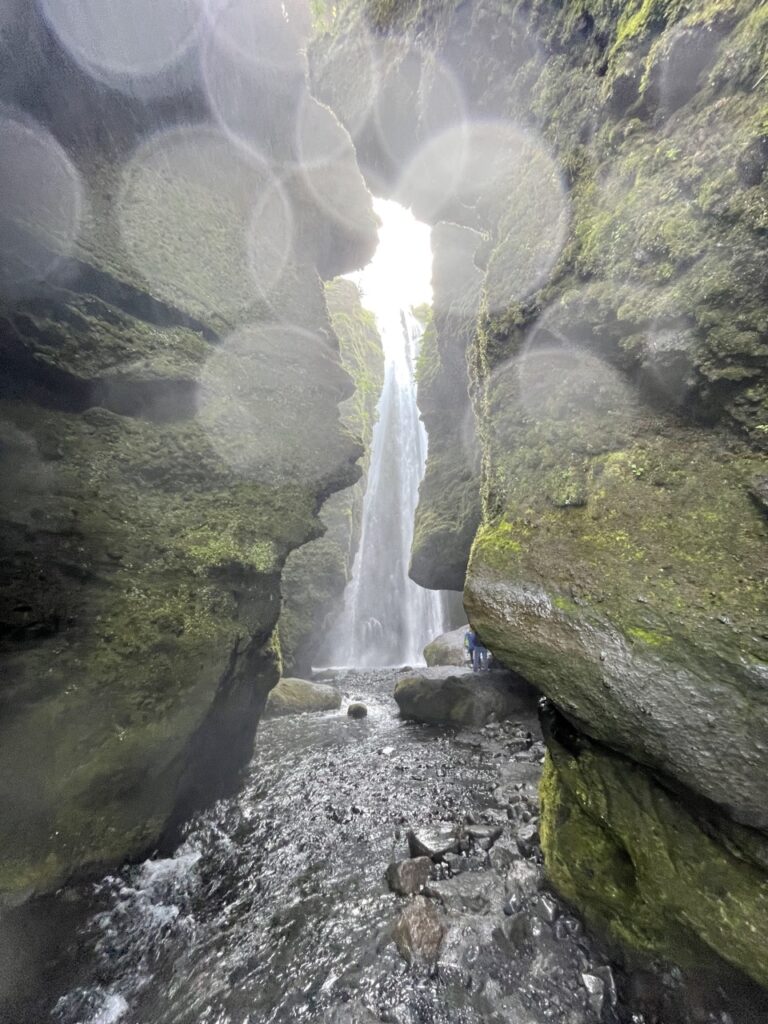
Even with low water, it is not an easy passage. The rock ‘walls’ of the entrance angle inward, so you can’t easily lean against them or even stand up straight. The rocks are small and wobbly, and also wet and slippery.
The passage is short, maybe 20-30 feet, and then opens up to the cavern. Once you’re inside, there’s more space and higher dry-ish rocks on which to stand.
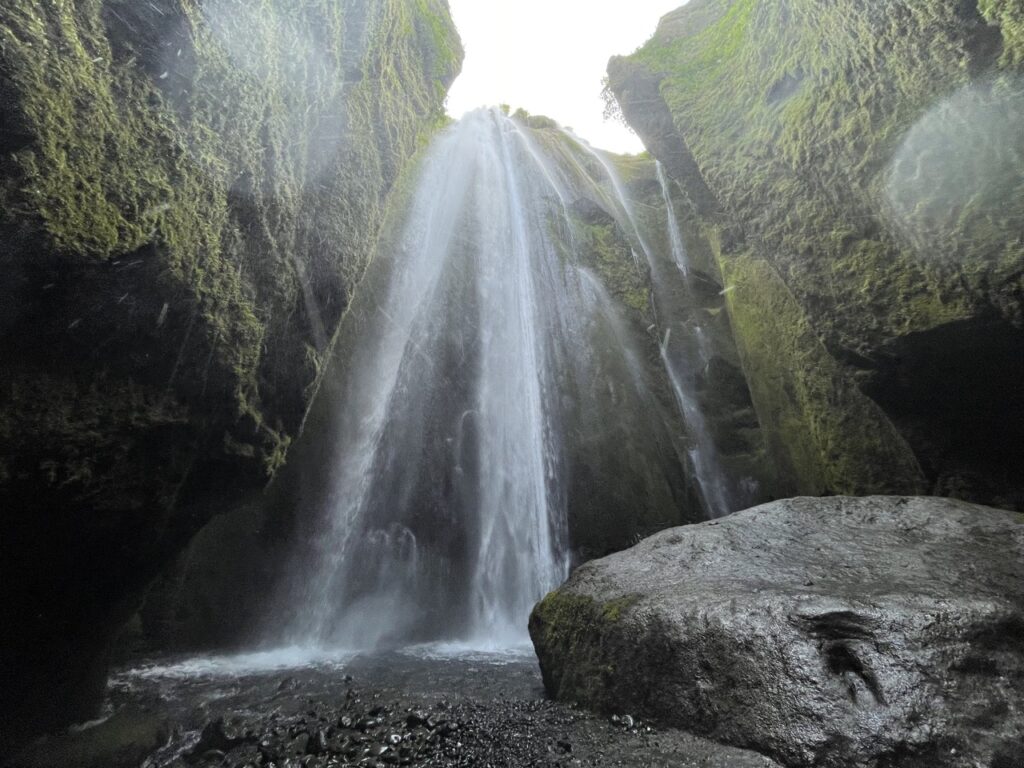
It’s possible to enter the cavern when the stream is low and the weather is warm, but that is not always the case. During periods of high rain or during the winter months, entrance to this cavern would be extremely dangerous and is not recommended.
Plan your Visit to Seljalandsfoss Waterfall
Seljalandsfoss waterfall is a popular destination for many types of travelers. Its location on Route 1 makes it a common stop for those traveling the full Ring Road, but it’s proximity to Reykjavik makes it an easy day trip, especially when combined with some other attractions in the area. (See below for itinerary tips.)
Regardless of the type of trip your taking, this section will help you plan the perfect visit to Seljalandsfoss waterfall.
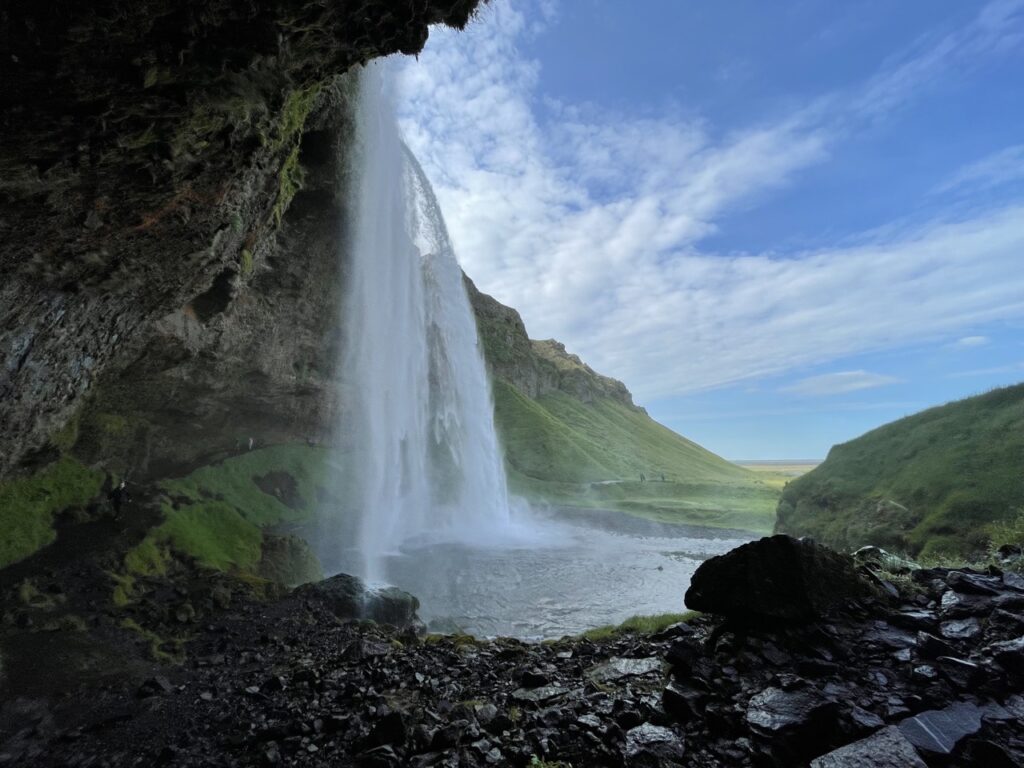
When to Visit Seljalandsfoss
Seljalandsfoss is open all year, but we recommend visiting in the summer (June – August). The most incredible thing to do at Seljalandsfoss is to walk behind the falls, and that path is closed in the winter.
Summer is also the warmest season in Iceland, with average temps in the 50s Fahrenheit. The falls in the area and the meadow around them are beautiful. It’s so pleasant to sit in the grass and just soak in the beauty of the falls. It also makes getting soaked from your walk around the falls suck a little less.

Summer months also mean more daylight. Iceland is so far north that daylight hours shift dramatically throughout the course of the year. In the summer, the sun sometimes doesn’t set until after midnight! More hours of daylight means you can literally see more during your trip to Iceland.
Do note that summer is peak tourist season in Iceland and Seljalandsfoss is one of the most famous waterfalls in the country. The falls are often crowded with tourists and photographers, even during “off” times of day. This is not a hidden gem that you’ll likely get to experience alone.
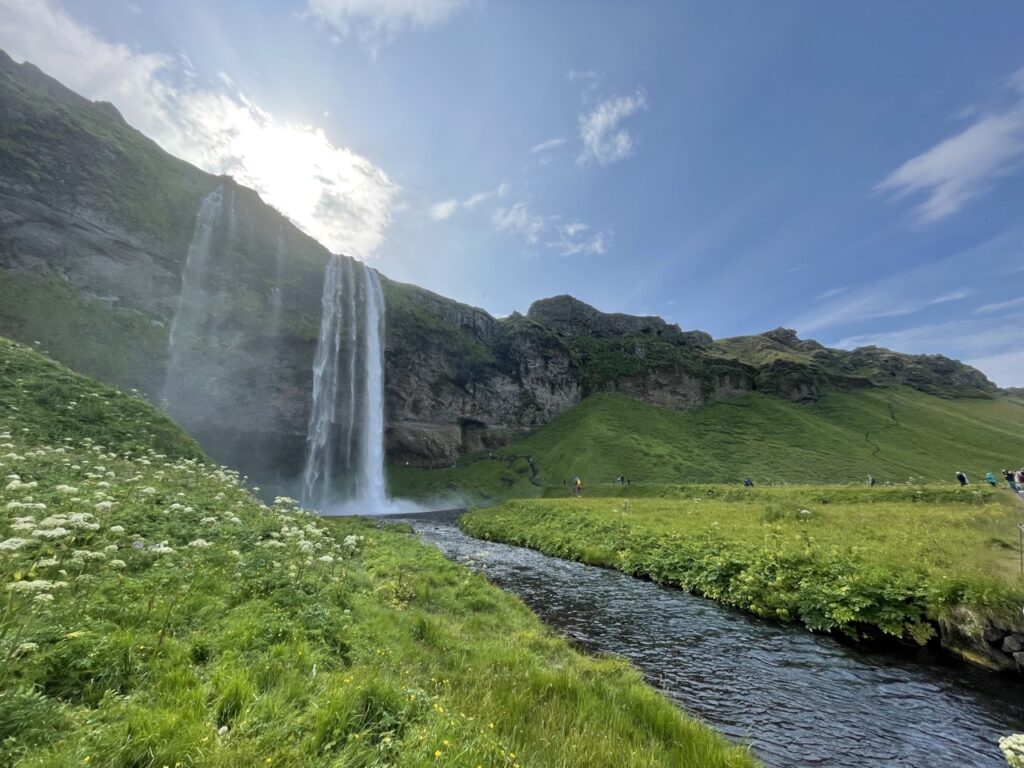
If you are looking for more solitude, we suggest you focus your time and energy on visiting Gljufrabui. You may also want to consider visiting some of the lesser known waterfalls in Iceland.
How Much Time to Spend at Seljalandsfoss Waterfall
As beautiful as Seljalandsfoss is, it’s still a single waterfall with not much else to do in the immediate area. For many, this would be considered a “photo stop.”
If you were planning to only walk behind Seljalandsfoss and take a few casual photos, you could probably do that in 30 – 45 minutes. We recommend spending a little extra time if you have it.
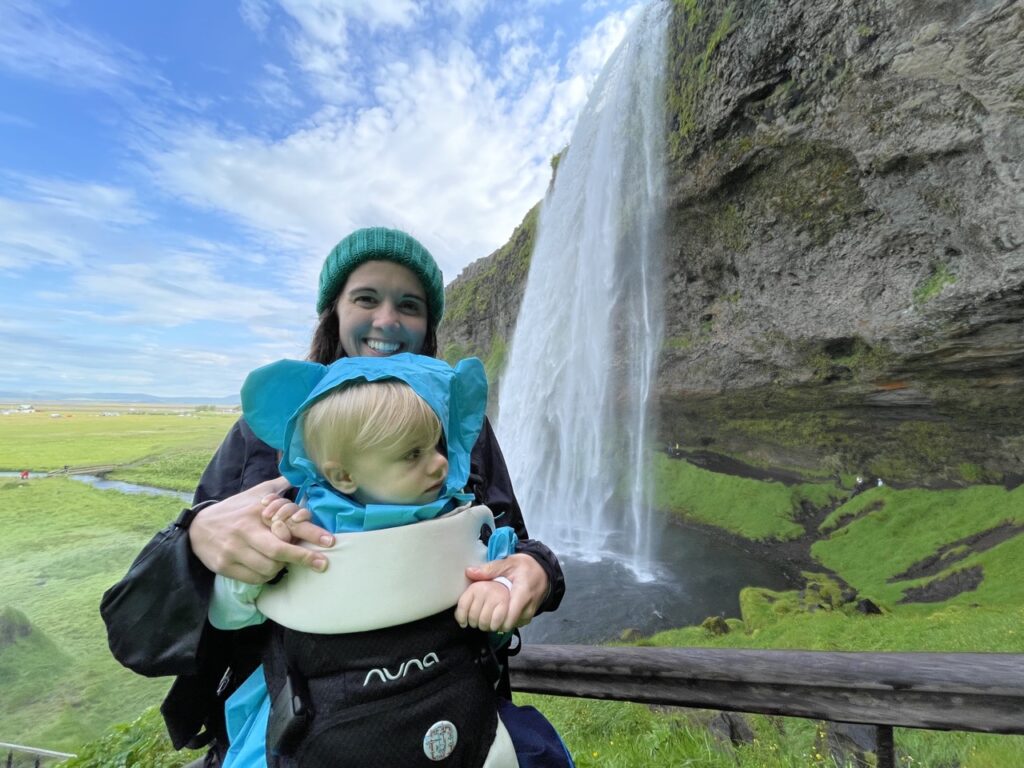
We suggest spending 1.5 – 2 hours at Seljalandsfoss. This includes walking the path behind Seljalandsfoss, visiting nearby Gljufrabui waterfall, and enjoying a coffee and/or a pleasant sit in the meadow.
If you’re a serious photographer, you may need to stay longer. We’ve heard that this waterfall can really try your patience. It can be tough to secure good lighting and a good photo without other visitors in your shot.
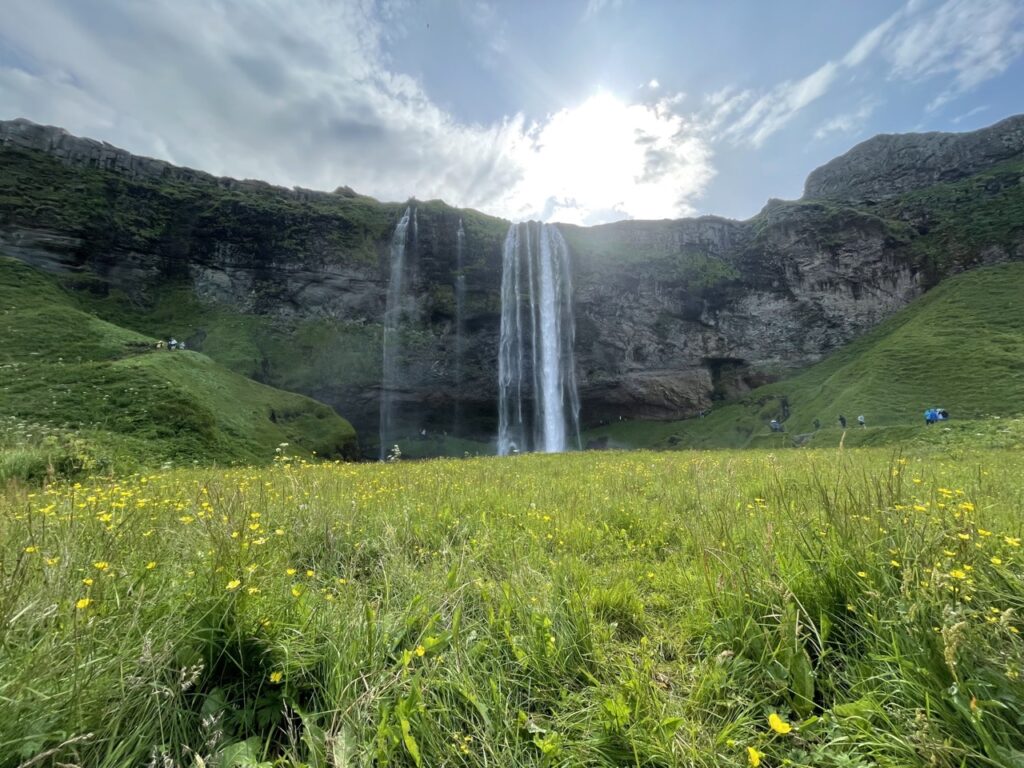
How to Get to Seljalandsfoss Waterfall
Some of the most popular sights in Iceland are the easiest to get to, and Seljalandsfoss falls into that category. Seljalandsfoss is conveniently located just off Iceland’s main highway about 85 miles southeast of Reykjavik.
To get to Seljalandsfoss, take Route 1 south out of Reykjavik. Just past the town of Hvolsvöllur, you’ll pass a small waterway and will be able to see the falls from the road. Take a left onto Þórsmerkurvegur, which will run right into the parking lot.

I should clarify. Seljalandsfoss is easy to get to … with a car. Unfortunately it’s not possible to take public transportation to this waterfall.
If you can’t or don’t want to rent a car, the other option is to take a tour. We recommend this South Shore Adventure with Reykjavik Excursions. It includes some of our favorite stops along the southern coast.
How Much Does it Cost to Visit Seljalandsfoss
The fee to visit Seljalandsfoss comes in the form of parking. It’s technically free to visit the falls, but parking at Seljalandsfoss costs 700 ISK (~$5.50 USD).
You can pay by credit card at one of the automated booths near the lot. At times, there may also be an attendant who accepts cash, but having a credit card is more reliable.
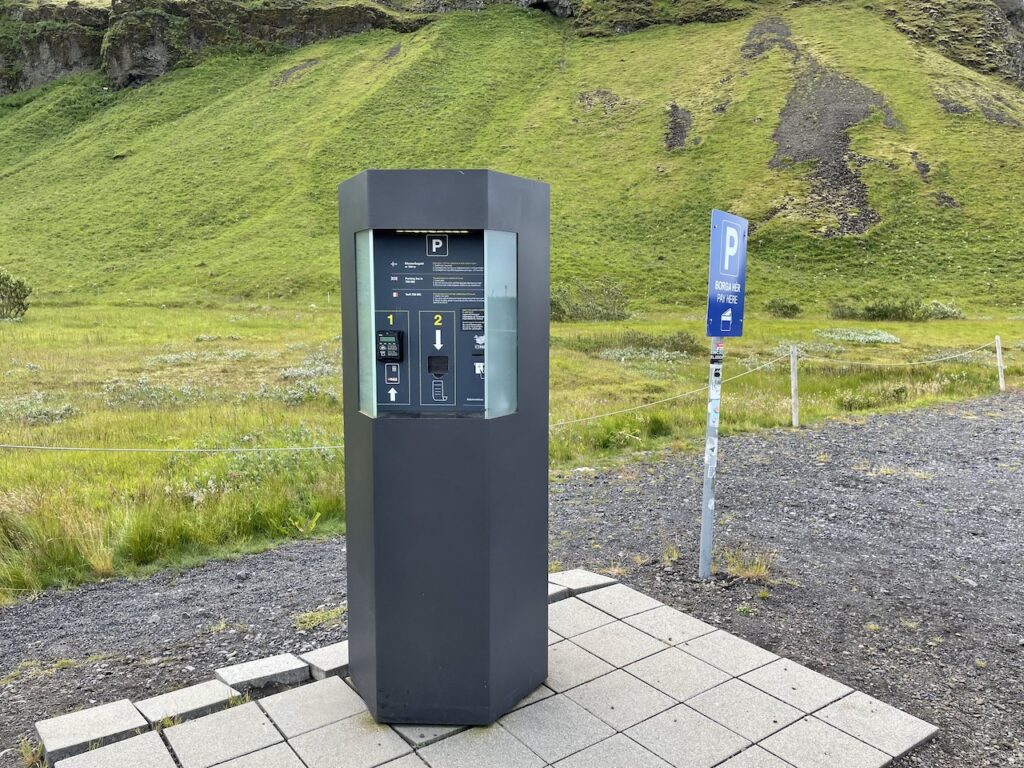
Amenities at Seljalandsfoss
Seljalandsfoss is one of the most popular waterfalls in Iceland, so the area around it is built up to support the volume of tourists visiting and ensure a pleasant visit. Here’s what you’ll find nearby.
- Wifi: No. To the best of my knowledge, the only free wifi was at the campsite, which I believe is closed now.
- Bathrooms: Yes, bathrooms are available and free to use.
- Parking: Yes for a fee of 700 ISK ($5.50 USD)
- Coffee: Yes, there’s a cafe truck that sells espresso and coffee beverages.
- Food: Yes, the cafe truck serves sandwiches, soup and pastries.
- Vegetarian Food: No, there was no vegetarian meal option beyond breakfast/dessert pastries.
- Souvenirs: Yes, there’s a small souvenir shop that sells standard knickknacks and traditional Icelandic wool sweaters. (It took everything in my power to not buy the hand knit puffin sweater for hundreds of dollars.)
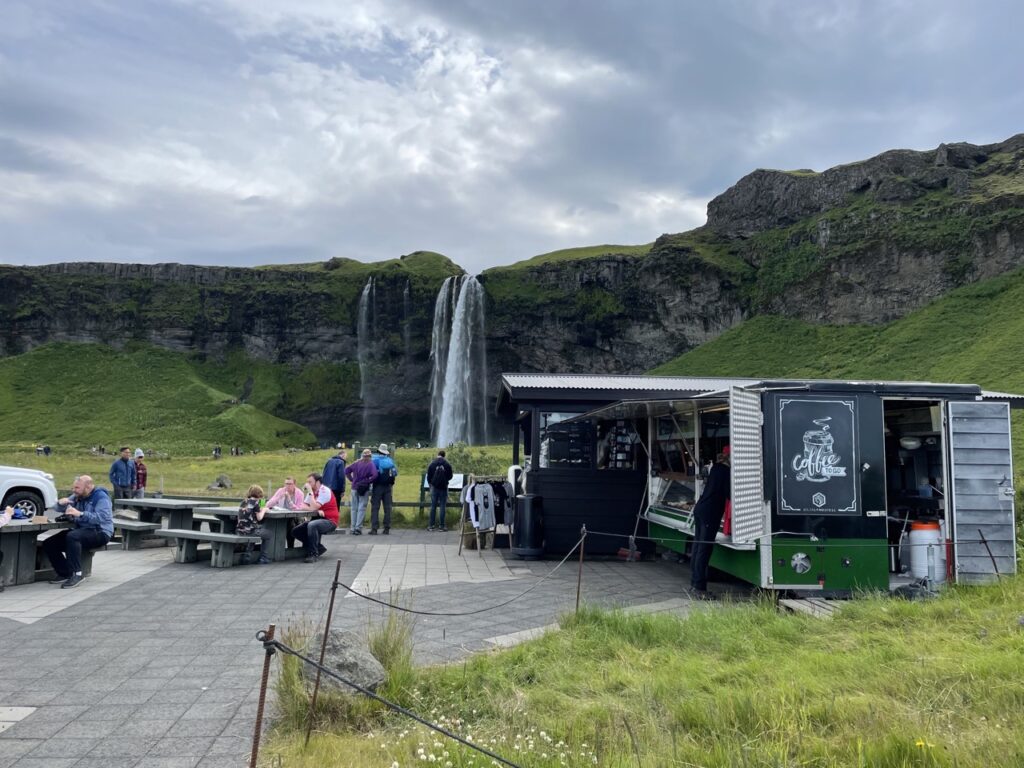
Tips for visiting Seljalandsfoss Waterfall
Before your visit to Seljalandsfoss waterfall, we have a few tips we’d like to send you away with. You may also want to check out our full Iceland minimalist packing list as you prepare for your trip.
General Tips for Your Visit
- Wipe your camera lens often. The mist from Seljalandsfoss and Gljufrabui is inescapable and can cause blurry photos in a heartbeat. Keep a lens cloth in a dry pocket and wipe your lens often.
- Stay for a while. One of my favorite memories of my Iceland trip was sitting in the meadow playing with our toddler against the backdrop of these stunning falls. I’m usually an activity person and want to do all the things on trips, but it was actually really nice to relax for a while.
- Try to see Gljufrabui. We’d recommend walking over to Gljufrabui to see if you can enter the cavern. The water may or may not be too high to go inside safely, but check it out. If it’s safe to enter, it’s an absolute gem.
- Take Photos from the Bridge. There’s a cute little bridge along the footpath not too far from the base of the falls, and it was my favorite photo spot. (I’m no photographer, though.)
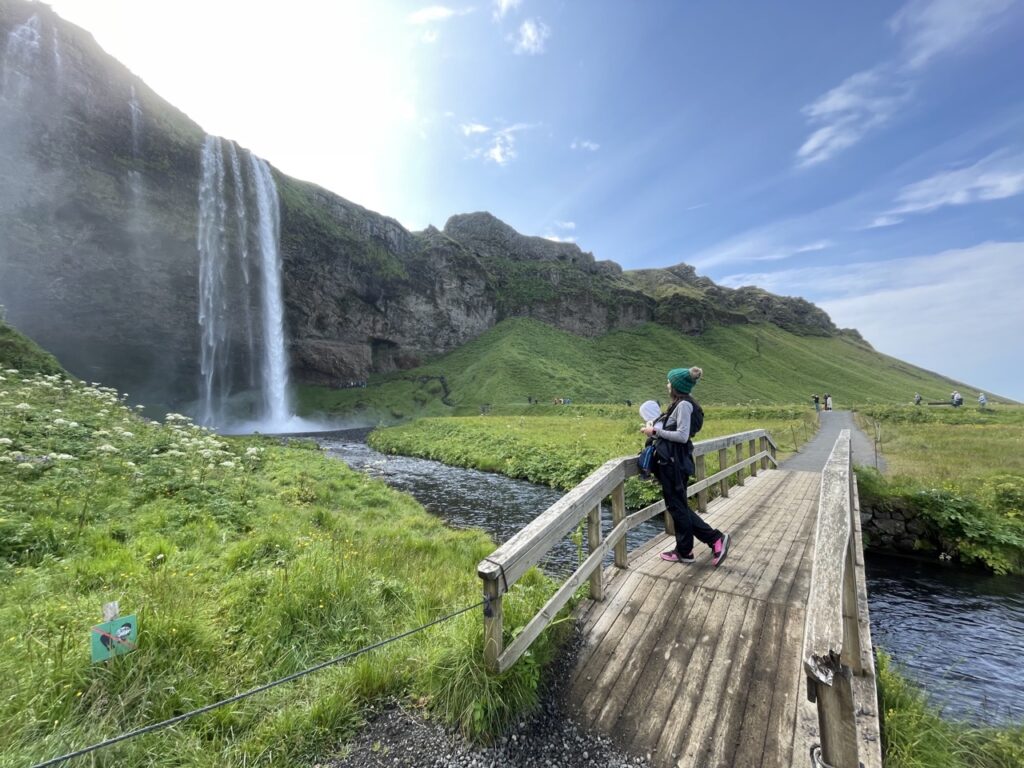
What to Wear
- Rain Jacket. If you walk behind the waterfall, you will get wet. A rain jacket is necessary here and honestly in all of Iceland. I loved this packable rain jacket as a backpacker because it packs light and is easy to have on hand. For this trip, though, I wore my bulkier North Face Apex Bionic jacket which is my favorite jacket of all time (windproof, waterproof and warm, though it doesn’t have a hood).
- Rain Pants. Rain pants look ridiculous and are pretty expensive, but honestly I was so glad I had them in Iceland. I snagged a clearance pair from Patagonia (here’s the current line) and wore them several times, including at Seljalandsfoss. In the cooler months of spring / summer, I could see rain pants being even more essential.
- Good Shoes. If you’re walking behind the waterfall, be sure to wear good shoes. The rocks and ground are wet and can be slippery. You will be fine with sneakers with good traction, and bonus points if they’re water resistant. Hiking boots or shoes would be a nice-to-have, but not essential.
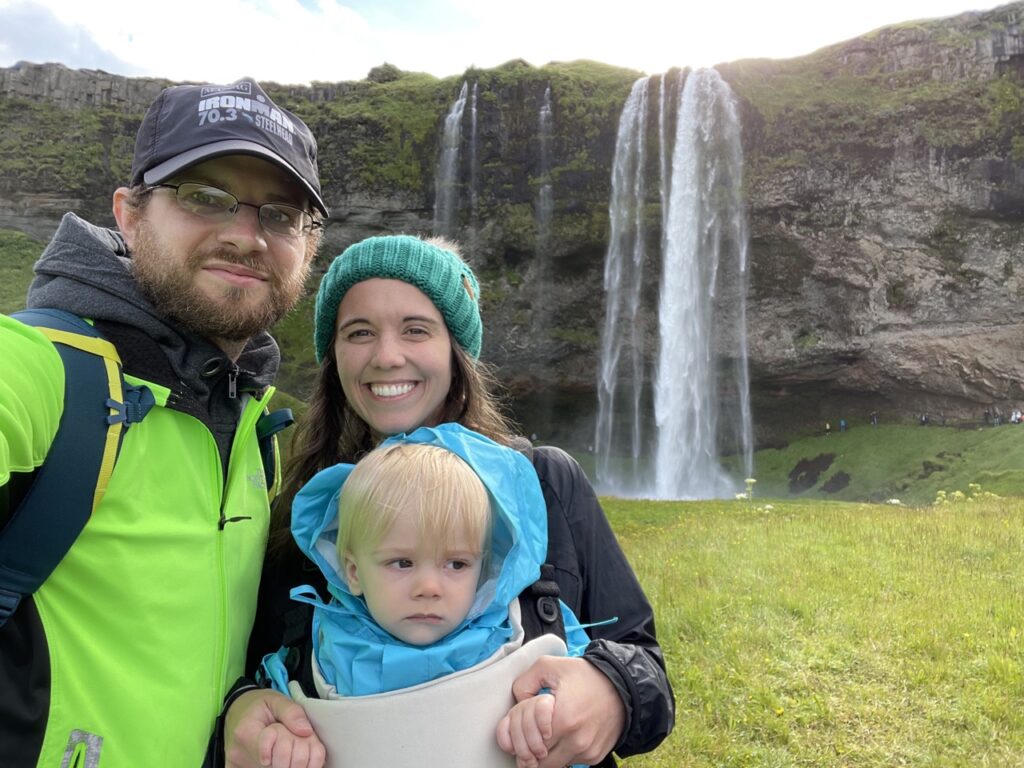
What to Bring
- Pancho. If you don’t have or don’t want to bring a rain jacket, a reusable poncho is a good alternative. If you’re traveling with a toddler, we recommend this children’s poncho. It’s adorable and easier than getting rain jacket and rain pants on a squirmy toddler.
- Lens Cloth. I didn’t have one, and was constantly fumbling under my rain gear to wipe off my camera lens on my dry clothes. A lens cloth would have been nice to keep in my pocket. I like this one because it comes with a clip.
- Waterproof Backpack Cover: We take our backpack with us everywhere. It holds essentials like passports and baby stuff like the diaper changing kit. We picked up this waterproof backpack cover to keep our stuff dry, and it was clutch at this waterfall.

Where to Stay Near Seljalandsfoss
Seljalandsfoss is a pretty remote waterfall and does not have a large town or village nearby. There are a few small guesthouses near the waterfalls, but we wouldn’t recommend them to most visitors.
There used to be a campsite located just beside Gljufrabui, which seemed to be quite popular. However, according to Google and to the best of my knowledge, I believe this campsite has actually closed. I’m unsure why as I believe it was pretty highly recommended. I’ll try to keep you posted if I learn more.
In either case, we don’t typically recommend staying near Seljalandsfoss.
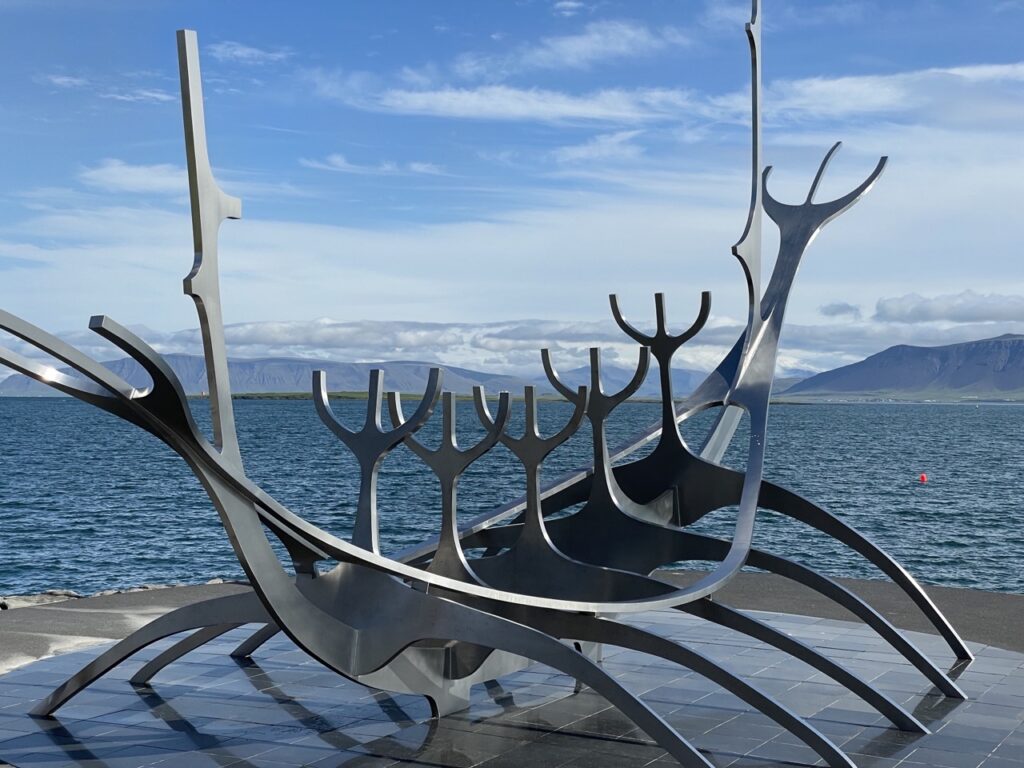
For travelers based out of Reykjavik, we’d recommend making Seljalandsfoss a day trip. Reykjavik has the best choices and prices for accommodations and is a good home base. We recommend staying at KEX Hostel in Reykjavik, which is a family-friendly hostel with a great location by the water and walkable to “downtown.”
For travelers looking to spend more time exploring the southern coast or who will be continuing on the Ring Road, we recommend staying in Vik. It’s the largest town for 40 miles in either direction and is a great oasis. We have a complete guide to Vik if you’re interested in planning a visit there.
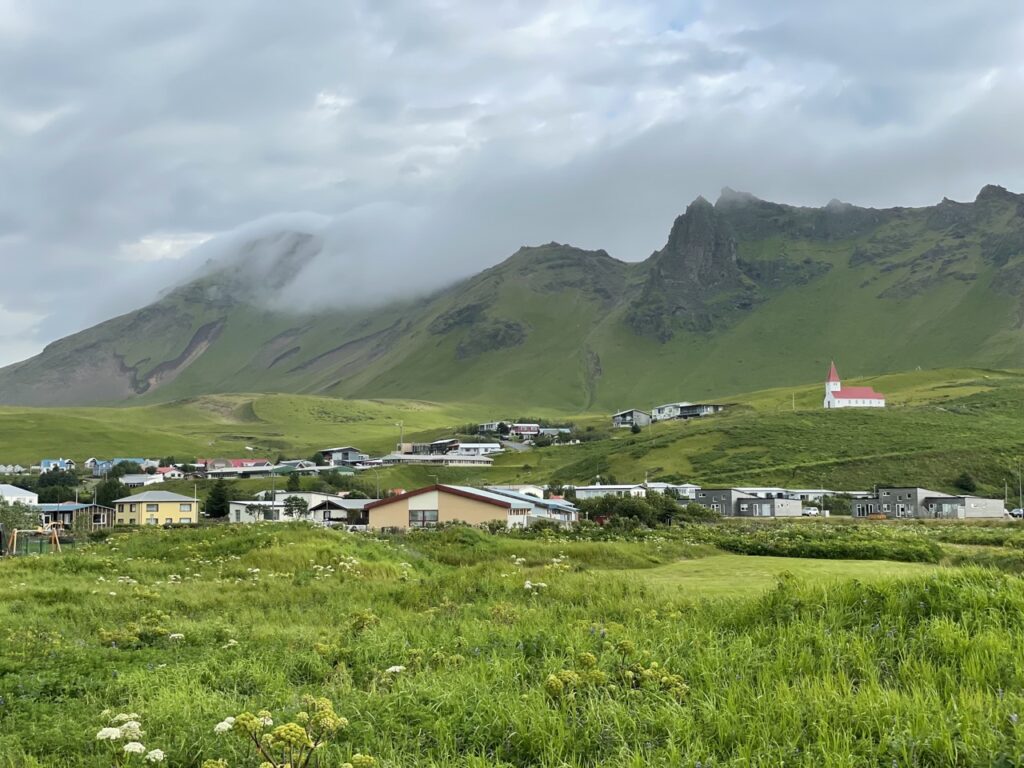
How to fit Seljalandsfoss into your Iceland Itinerary
The great thing about Seljalandsfoss is that you can fit it into just about any itinerary. Whether you’re in Iceland for a few days or a few weeks, it’s possible to take a walk behind this waterfall. Here are a few ways to fit Seljalandsfoss into your Iceland travel plans.
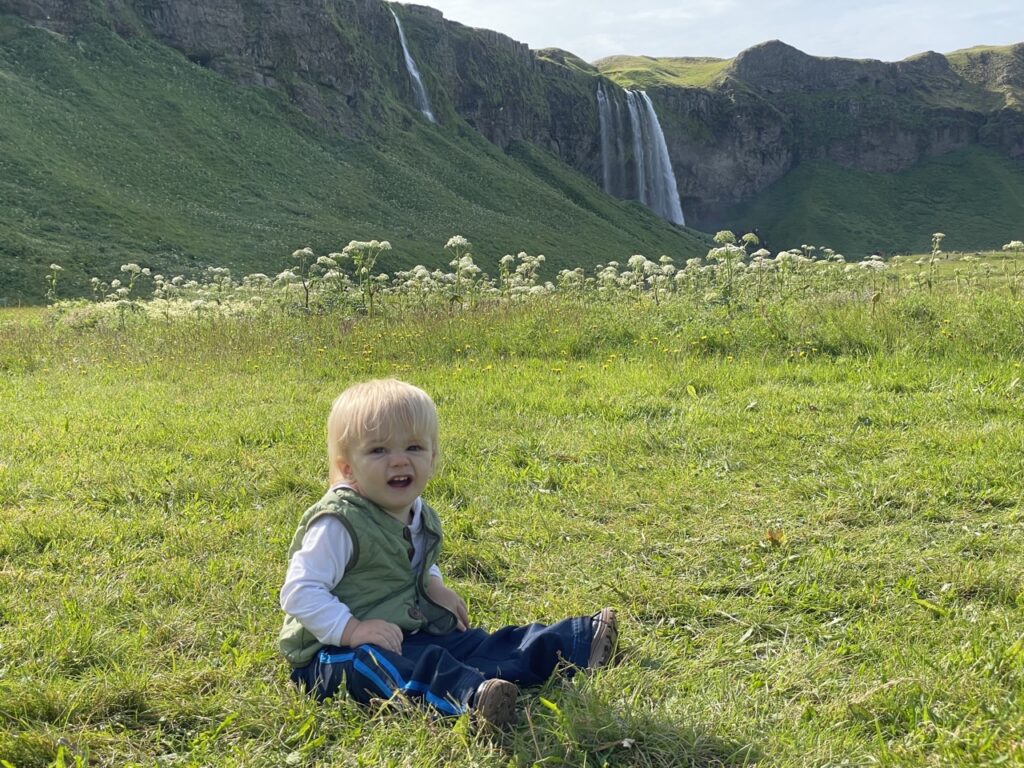
Southern Coast Day Trip from Reykjavik
Some of Iceland’s most beautiful destinations can be found along the southern coast. You can combine some of the best attractions into a single day’s road trip from Reykjavik.

This sample itinerary starts at Seljalandsfoss and includes stops at Skogafoss waterfall, Dyrhólaey lookout and lighthouse, and Reynisfjara black sand beach.
We’d recommend spending about 1.5 hours at each attraction, which comes out to 6 hours of activities and 5.5 hours of driving.
Golden Circle Extension
Another good option would be to combine the Golden Circle with a few extra waterfalls on the southern coast. This option would make for a long day, but if you’re short on days in Iceland it’s a great option.
The Golden Circle refers to a trio of attractions: Thingvellir National Park, Geysir Hot Spring Area and Gullfoss waterfall. If you self-drive the Golden Circle, take your trip up a notch with visits to two waterfalls: Seljalandsfoss and Skogafoss.
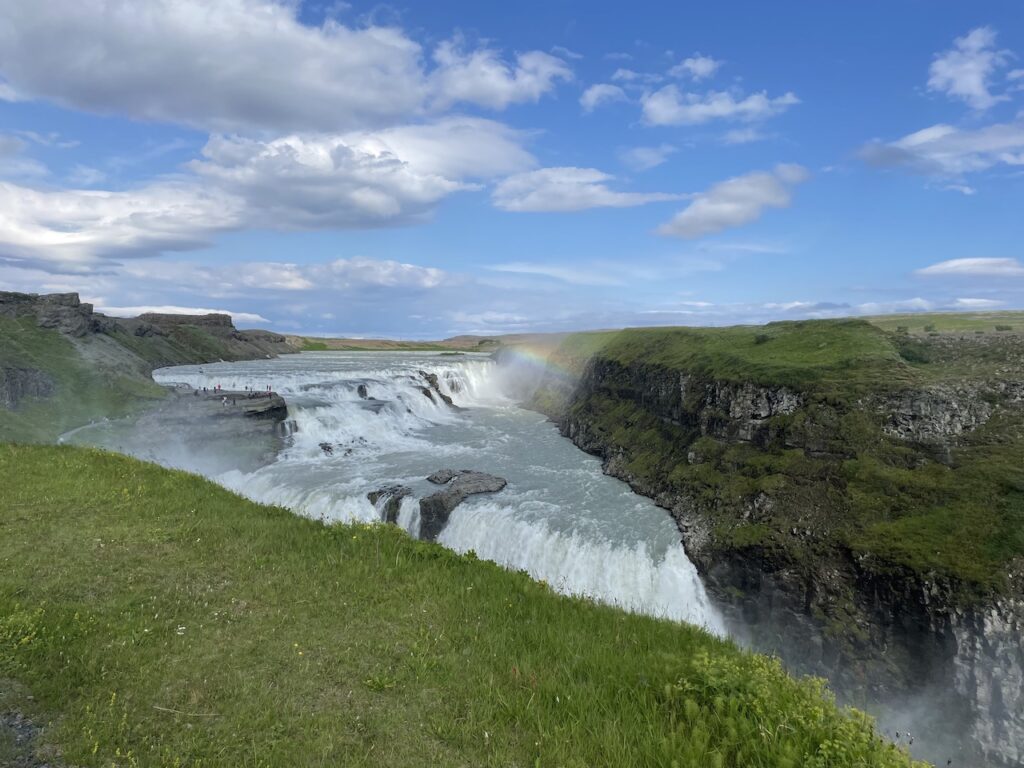
You’d probably want to spend 2 hours at Thingvellir and about an hour at each other attraction. This would total 6 hours of attractions, but plan for 7-8 to be safe. Add that to 6 total hours of driving and you’re looking at a 12 – 14 hour day.
We’d only recommend this option in the summer months when you’re guaranteed daylight for 12+ hours.
Ring Road Roadtrip Stop
There is one road that forms a ring around the entire island of Iceland known as the Ring Road or Route 1. In the summer months, the Ring Road is a popular roadtrip option for some of the more adventurous tourists.
The road trip is famous for its epic landscapes including glaciers, volcanoes and absurd number of amazing waterfalls. There are countless things to see and places to go along along the 825-mile loop around the country.
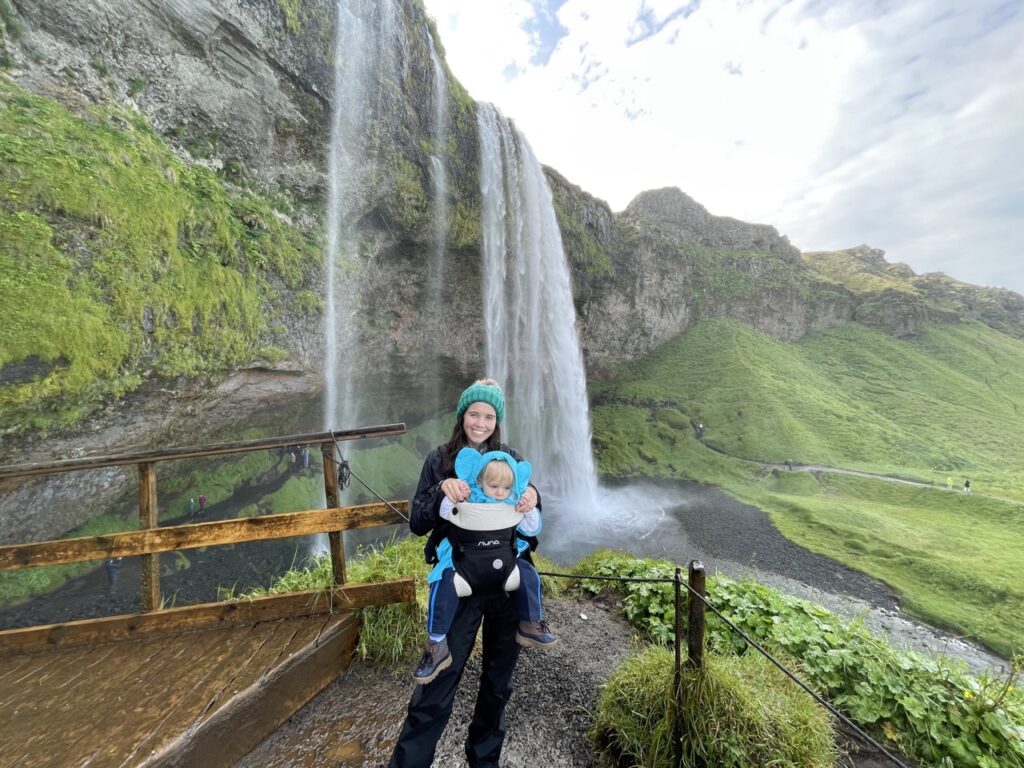
We personally did not drive the full Ring Road and stuck to the southern coast, so I don’t have a ton to say about this journey. But I can say that Seljalandsfoss is located right off of this main road and is absolutely worth stopping at, even just for a few minutes and a quick walk.
If you’re interested in the full Ring Road, there are a ton of great resources like this complete guide from Expert Vagabond.
Conclusions
We say this a lot, but we’re firm believers that popular things are popular for a reason and we don’t turn up our nose at them. This is a popular attraction in Iceland, but it deserves the attention it gets.
It’s a beautiful waterfall with the unique component of being able to walk behind it. Having the chance to discover the hidden falls of Gljufrabui was just the icing on the cake.
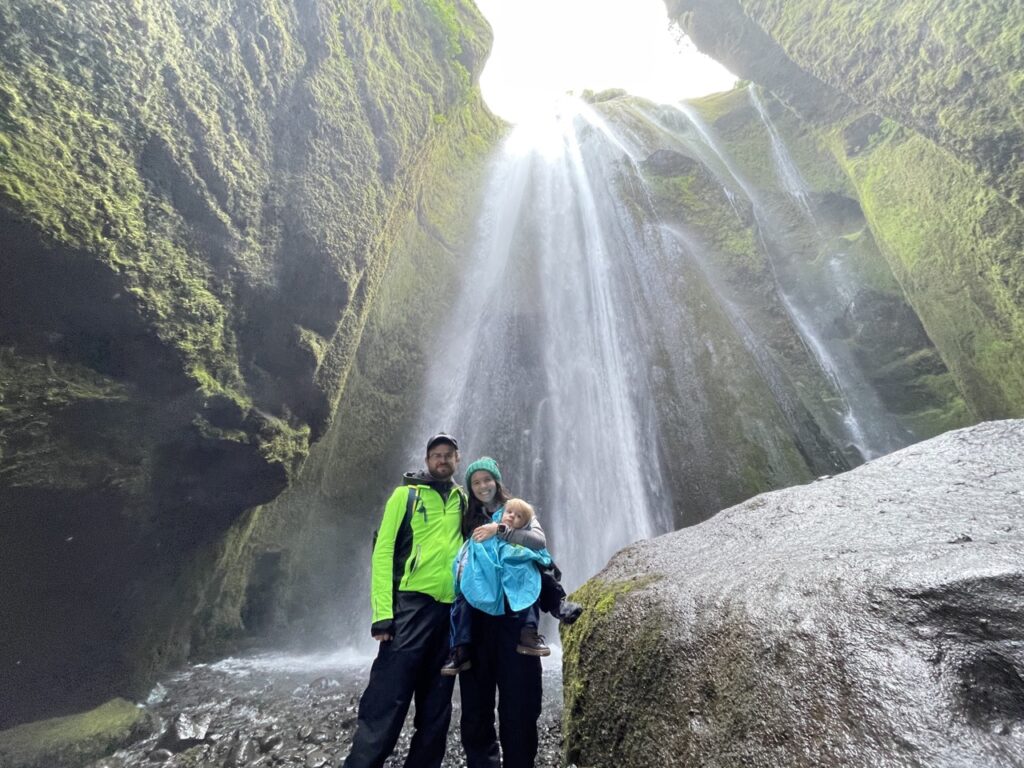
This was one of the first waterfalls we saw in Iceland and was definitely one of our favorites. I hope you enjoy it, too, and that you found this guide helpful!
Whether you’re in Iceland now or planning your dream trip, we hope you have an amazing adventure.
Our Full Iceland Itinerary
Planning a trip to Iceland? Here’s a look at our full itinerary for this trip…
- Minimalist Iceland Summer Packing List (That Fits in One Carry-On!)
- Detailed 3-Day Reykjavik Itinerary with Walking Routes
- Reykjavik City Guide – Everything to Know About Iceland’s Capital City
- Whale Watching in Reykjavík with Special Tours
- Planning Guide: Self-Drive the Golden Circle in Iceland
- Guide to Thingvellir National Park in Iceland
- Guide to Gullfoss Waterfall in Iceland
- Guide to Iceland’s Geysir Hot Spring Area
- A Perfect Visit to Seljalandsfoss Waterfall + Bonus Hidden Waterfall
- Planning Guide: Skogafoss Waterfall in Iceland
- Guide to Dyrhólaey Nature Reserve on Iceland’s Southern Coast
- Complete Guide to Vik, Iceland
- Guide to Reynisfjara Black Sand Beach in Iceland
- Guide to Jökulsárlón, Iceland’s Glacier Lagoon
